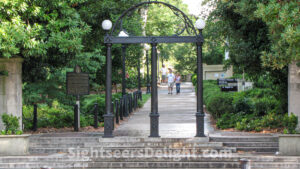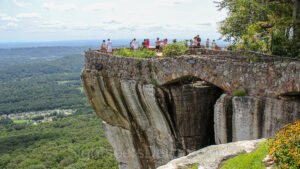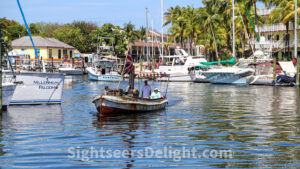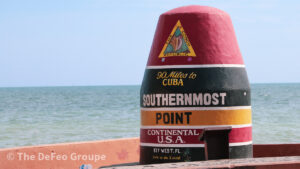The Arch was constructed in the 1850s as part of a larger iron fence protecting the university campus. It is generally regarded as the entrance to both the University of Georgia and the city of Athens. The Arch comprises three pillars representing Georgia’s state motto: “Wisdom, Justice, and Moderation.”
30602
What is today Rock City has been a popular tourist attraction for years. But, it was until the 1930s that the Rock City of today began taking shape. Frieda Carter, whose husband, Garnet, fashioned one of the country’s first miniature golf courses and a housing development atop Lookout Mountain, built a walkway and rock garden for the people living in the development. To promote the new attraction, which officially opened on May 21, 1932, Carter’s husband hired Clark Byers to paint farmers’ barns – for free, if the barns’ owners would let him paint “See Rock City” on the roof. The campaign worked; the slogan not only helped to draw guests to Rock City, it also became one of the most recognized advertising tag lines of all time. Today, Rock City features winding, garden-lined trails. But, the highlight is Lover’s Leap, a natural overlook where travelers can supposedly see seven states from one spot.
30750
Crews building the Western & Atlantic Railroad from Atlanta to Chattanooga, Tenn., faced a number of natural obstacles. None, however, were as foreboding as Chetoogeta Mountain. What workers built was a 1,477-foot-long engineering phenomenon that has stood the test of time. Work on the tunnel started on July 15, 1848, and the first train rolled through the tunnel on May 9, 1850. The railroad actually started rail service between Atlanta and Chattanooga in the 1840s. The tunnel remained in service until 1928 when a new tunnel opened a few feet away to accommodate larger trains. For years, the older tunnel sat unused, and eventually fell into disrepair.
30755
Rock Hawk Effigy Mound is comprised of thousands of pieces of quartzite. While referred to as a hawk, scholars do not know what type of bird the original builders intended to portray. The mound is one of two such effigy mounds found east of the Mississippi River. Current archaeologists believe Woodland Indians built the site between 1,000 and 3,000 years ago. These Native Americans may have been part of the Adena or Hopewell cultures, or they may have represented a different group.
31024
The Palace Saloon claims the title of the oldest bar in Florida and the last American tavern to close during Prohibition. Josiah Prescott built the structure, which opened in 1878 as a haberdashery. But, Louis G. Hirth purchased the structure in 1903 and converted it to the Palace Saloon. The establishment was apparently a favorite haunt of famous socialites, including the Carnegies and the Rockefellers. On the eve of Prohibition began, the bar apparently reported $60,000 in bar receipts, supposedly the most profitable day for the establishment. The establishment survived the dry era as an ice cream parlor until 1931 when the booze began flowing again,
32034
The Kennedy Space Center Visitor Complex is 45 minutes east of Orlando International Airport. It brings to life the epic story of the U.S. space program through immersive and interactive experiences. Exhibits highlight the history of space exploration, including s Saturn V moon rocket and the Space Shuttle Atlantis. The U.S. Astronaut Hall of Fame is located on the center’s grounds.
32953
The African Queen is a historic steamboat located in Key Largo, Florida. Built in 1912, the vessel gained worldwide recognition after being featured in the 1951 film “The African Queen” starring Humphrey Bogart and Katharine Hepburn. Today, visitors can take a 90-minute cruise on the African Queen, exploring the beautiful waterways of Key Largo while learning about the boat’s fascinating history. The boat has been meticulously restored and is a beloved attraction in the area, providing a unique and memorable experience for visitors of all ages.
This post partially incorporates text generated with GPT-3, OpenAI’s large-scale language-generation model.
33037
The Southernmost Point Buoy is a concrete buoy that ostensibly marks the southernmost point in the continental United States and is a popular photograph for tourists. The buoy, which sits at 18 feet above sea level, was established in 1983 at South and Whitehead streets. Cuba is about 90 miles south of the point, but the exact distance is disputed, as is the southernmost point claim. The southernmost point was initially marked with a small sign before city officials erected the buoy in 1983. Hurricane Irma damaged the paint job in September 2017, but the original artist, with support from the city of Key West, refurbished it.
33040
The Manatee Observation and Education Center is located on the waterfront in downtown Fort Pierce, Fla. The environmental education and wildlife viewing center opened on Nov. 1, 1996, in time for Manatee Awareness Month. The mission of the Manatee Observation and Education Center is to promote understanding and responsible actions for the protection of the Treasure Coast’s fragile ecosystems and their inhabitants. It does that through exhibits and an outdoor viewing platform where visitors can watch manatee.
34950
The Upland Trail is a walking path in the heart of downtown that dates to the late 1990s. The trail currently links the Riverwalk to an overlook bridge at the north end of Valleybrook Park. The initial portion of the project extended the trail from the pedestrian overpass on Riverside Drive and College Street, alongside many of Clarksville’s historical buildings and homes, and uses a former railroad bridge near the park. The remainder of Phase II will eventually continue the trail into Valleybrook Park.
37040






